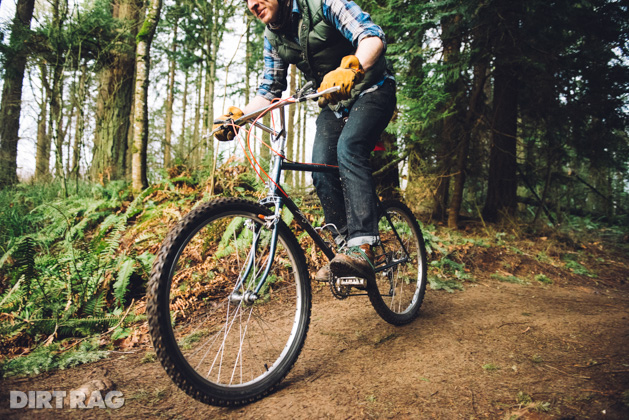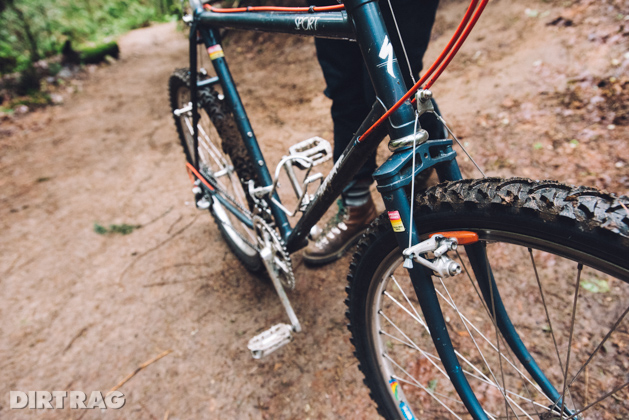Blast From the Past: 1984 Specialized Stumpjumper
Originally posted on March 17, 2016 at 12:20 pmPhotos by Justin Steiner, Adam Newman and Kyle Heddy
In the new issue of Dirt Rag, #190, you’ll find our side-by-side-by-side comparison of the latest and greatest Specialized Stumpjumper FSR models. Now available in three wheel sizes, it’s likely the longest-tenured mountain bike model in existence, after company founder Mike Sinyard introduced it to the world in 1981.

2016 Specialized Stumpjumper FSR 6Fattie
The 2016 Stumpjumper FSR has generous helpings of carbon fiber, hydroformed aluminum, tubeless wheels, larger tires, SWAT storage inside the frame, advanced suspension and hydraulic disc brakes. The 1984 edition pictured here has not one of those things. We acquired it from the impressive collection of vintage mountain bikes at Velo Cult bike shop in Portland, Oregon, and decided to get it dirty.

1984 Specialized Stumpjumper Sport
Now, this bike is older than some of our employees and likely many of our readers, so don’t expect modern performance. Comparing it to a modern bike more than three decades newer just doesn’t seem fair. But we’re going to do it anyway.


Let’s start with the frame. Steel? Nothing unusual there. Plenty of great steel bikes on the market these days. But, lugs? It’s rare to see them outside of a NAHBS show hall these days. The geometry will have some modern riders scratching their heads, too. A 67 degree head tube angle seems fun, but the 69.5 seat tube angle and 18.75 inch chainstays are about as opposite from today’s style as you can get. Then again, it is remarkably stable, comfortable and well-suited to the adventures of the day. On the trail, the long wheelbase helps keep you feeling centered in the bike, but it definitely prefers to keep two wheels on the ground. (Most of the time.)

The highlight here is the beautiful dual-plane fork crown, a feature that disappeared shortly after with the introduction of unicrown forks. You’ll also find rack and fender mounts, a testament to the versatile nature of these early mountain bikes and the variety of ways they could be used.

The aluminum wheels and lightweight tires were the real magic that made “fat-tire” bikes happen. They shed pounds of weight off the old steel rims and heavy balloon tires of the past. The Maxxis tires here aren’t original, but they look the part and offer a surprising amount of traction.

The Shimano cantilever brakes are … let’s say “adequate.” They have a positive feel and good modulation but, to be fair, they modulate between “sorta slowing” and “OH S%&#!” The huge, motorcycle-style brake levers help you get four fingers on there, but that doesn’t leave many on the handlebars for control. In a recent interview, Charlie Kelly told me the single biggest innovation in cycling has been disc brakes, and now I believe him.
“I started my off-road career in a time when the brakes were obviously the weakest system on the bike and they remained the weakest system on the bike for 20 years,” he said. “Disc brakes have revolutionized [mountain biking] even more than suspension, if you ask me.”


The drivetrain runs through a collection of parts that probably didn’t expect to meet each other on a single bike. The SunTour thumb shifters work great—as long as you’re not shifting too often—and are mated to early Shimano Deore XT derailleurs. Steering runs through a threaded headset (Remember those? They’re the carburetor of the bike world.) and mates to a beautiful bullmoose handlebar, as invented by Tom Ritchey. The crankset is a Shimano Tourney XT unit with—count ‘em—three chainrings and a freewheel with half as many cogs as a modern cassette.

And the suspension? I looked all over but didn’t see any. The quick release seat clamp means you can lower your saddle for descending, but that’s about the only consolation to gravity, a far cry from today’s trail bikes. While it’s still fun to blast downhill, it also results in a lot of bumping, bouncing and banging from the chain slap.

Let’s go back and put this bike into some perspective. In the early 1980s, what was considered “mountain biking” was more akin to today’s gravel touring and adventure riding. The era of NORBA racing, 140mm stems, skinsuit downhill racing, huge Mountain Dew contracts and a free mountain bike with the purchase of a Volkswagen was still years away. In fact, what to call this kind of riding on dirt paths and hiking trails hadn’t even been settled. I found a great article in the May 1983 issue of Bicycling magazine by John Schubert that highlights this newfangled trend of “lightweight fat-tire bikes.”
“Indeed, there is no general agreement on a generic name for these bikes. People I’ve talked to rule out ‘klunker’ because it sounds undignified, ‘cruiser’ because it refers to limited-purpose beach cruisers, ‘off-road bike’ because they’re quite usable on-road, and ‘MountainBike’ because it’s a trademark.”
The owner of that trademark at the time? Mr. Kelly, in fact.

In that same article a Stumpjumper Sport just like this one features prominently. It’s also mentioned in a sidebar about organized off-road touring groups. Hmm… sound like any currently popular trends? There’s even another section about riding “ballooners” on cross-country ski trails—more than 20 years before fat bikes would arrive. In October 1982, two Colorado bike shop owners organized a race in Boulder through eight inches of snow. The winner was Kent Eriksen, founder of Moots and current NAHBS award winner with his own brand.
The prize for winning? A Specialized Stumpjumper.

Read all about the 2016 Specialized Stumpjumper FSR in our three-part review of the 27.5, 27plus and 29er versions in Dirt Rag Issue #190, on sale now.